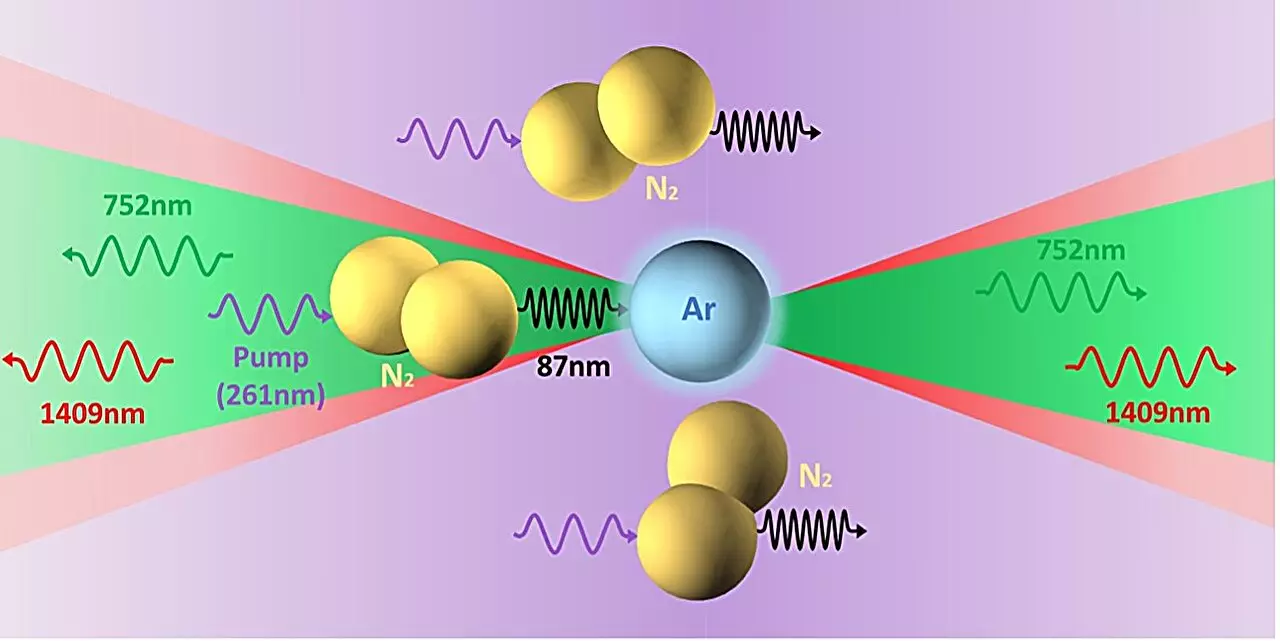The exploration of light generation has long relied on carefully engineered systems, primarily lasers, which depend on intricate optical cavities that amplify light through repeated reflections. However, recent advancements are challenging traditional paradigms, paving the way for novel insights into how light can be generated in open air, a phenomenon whimsically termed cavity-free lasing. This groundbreaking research from a collaboration between the University of California, Los Angeles (UCLA) and the Max Born Institute reveals a fascinating mechanism of energy transfer between nitrogen and argon gases, enabling emission processes once thought impossible outside the strict confines of a laboratory.
The Mechanism Behind Cavity-Free Lasing
Researchers detailed their findings in a paper published in *Physical Review Letters*, where they describe an intriguing energy exchange mechanism mediated by photons. The team, led by researcher Chan Joshi, observed that the ionization rate of argon in high field regimes deviated from expectations set by prevailing theories, namely the PPT theory and the time-dependent Schrödinger equation. This discrepancy raised questions about the role of 3-photon resonant absorption, especially of a 261 nm pump laser wavelength that their experiments employed.
The team’s innovative experiments confirmed that when argon atoms absorb these photons, they emit light in a unique manner: cascaded superfluorescence. This process allowed for light emissions that exhibited laser-like qualities, all without the conventional optical cavity setup. Moreover, lead author Zan Nie added an exciting twist—when argon was introduced into air containing a mere 1% mix of the gas, the emitted light wavelengths shifted, illustrating the complex interplay of different atmospheric components.
The implication of these findings is profound. The researchers pointed out that the coupling between nitrogen and argon is crucial for this air lasing process, providing insights into how these prevalent atmospheric gases interact at a quantum level. Joshi noted the success of mixing nitrogen with argon, identifying a tangible connection that standard gases, like oxygen or helium, failed to replicate in this lasing setup.
The lasing mechanism discovered activates at a molecular level; nitrogen molecules, when excited electronically, demonstrate nonlinear (3-photon) absorption, which is essential in triggering the observed emissions. By presenting a theoretical model that highlights these interactions, the researchers create a foundation for future investigations that could delve deeper into the superfluorescent processes involved.
The aspirations behind this research are not merely academic; they hold potential for real-world technology innovations. Misha Ivanov, another co-author, expressed excitement about the possibilities of this two-way laser interaction. The ability to create a feedback loop of laser-like emissions in open air could revolutionize remote sensing technologies, making them more efficient and practical. This concept of “backward lasing,” where an emitted signal returns to its source, highlights a direction that could yield immense benefits across various fields, from environmental monitoring to telecommunications.
Looking ahead, the research team is poised to investigate additional facets of this mechanism, specifically quantum phenomena like quantum beating, which they speculate may lead to a better understanding of the oscillatory density of charge across argon and nitrogen. Understanding these oscillations could unveil deeper secrets, including undiscovered energy levels in argon and the vibrational-rotational dynamics of nitrogen, thus enriching our grasp of atmospheric behaviors.
This pioneering study into cavity-free lasing opens a door to a new realm in atmospheric optics, challenging long-standing theories of light generation. With further exploration of the interrelations between gases, scientists may discover more about the fundamental nature of light itself and its implications for technology. The findings are not only an aesthetic triumph of scientific inquiry but a pivotal move toward harnessing the natural atmosphere in innovative ways—a pursuit that blends cutting-edge physics with practical application in the broader context of modern scientific discourse. As the researchers delve deeper into the convoluted landscape of atmospheric dynamics, the potential for transformative advances looms large, signaling an exciting future for the field of atmospheric optics.


Leave a Reply